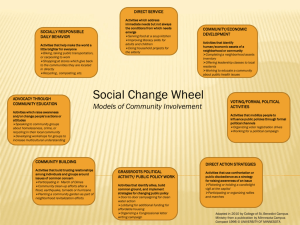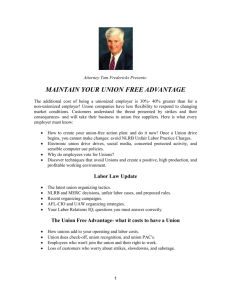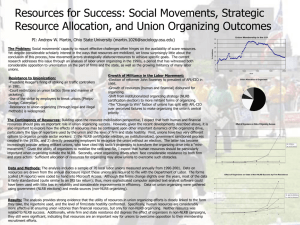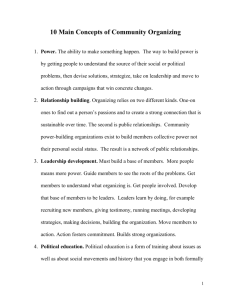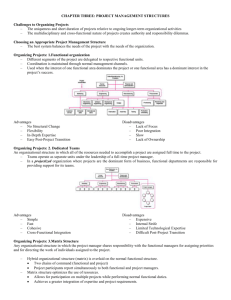union - Jacksonville Society of Human Resource Management
advertisement
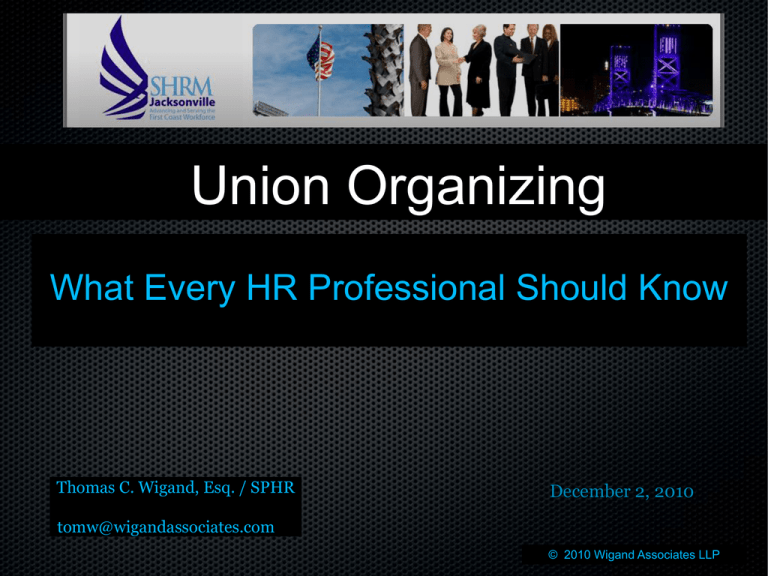
Union Organizing What Every HR Professional Should Know Thomas C. Wigand, Esq. / SPHR December 2, 2010 tomw@wigandassociates.com © 2010 Wigand Associates LLP Insight Understanding … Not just the theory, but the “real world” practice … Enables sound decision-making Current “Targeted” Industries “Jobs that can’t be ‘off-shored’” Public sector / government contractors Health Care – nursing homes; home health aides Hospitals – nurses; CNA’s; support staff Hospitality – Tourism - Restaurants Banking (tellers) Janitorial etc. – low-skilled / immigrants Even well-run organizations in a targeted industry and/or geographic area can be a target What is your personal attitude concerning labor unions? What is your company’s attitude concerning labor unions? What is that of your employees? The Power of Narrative Repetition w/o challenge breeds the “conventional wisdom” Conventional wisdom frames perceptions “Perception is ‘reality’” 1984: “Newspeak” - “Doublethink” “The purpose of Newspeak was not only to provide a medium of expression for the world-view and mental habits proper to the devotees … but to make all other modes of thought impossible.” -1984 by George Orwell Doublethink: “The power of holding two contradictory beliefs in one's mind simultaneously, and accepting both of them...” “To tell deliberate lies while genuinely believing in them, to forget any fact that has become inconvenient, and then, when it becomes necessary again, to draw it back from oblivion for just so long as it is needed” - 1984 by George Orwell Management Labor Labor & Management Battling Is the Natural Order of the Universe And Without a Union ... Workers Will Be Exploited By Management Union Myths (More of the “narrative”) • Union is the underdog • “VOICE” in the workplace • Most employees want a union • Unions created the middle class • The “union premium” for wages & benefits • Union represents employees -- only has workers’ best interests at heart How Organizing Works (or is supposed to) “Showing of Interest” – 30% by “community of interest” Voluntary employer recognition of “majority support” -- (50% +1) OR … Secret ballot election conducted by NLRB after campaign (note that the union controls timing) Certification by NLRB of employee representative to collectively bargain over “wages, hours and working conditions” How Organizing Often Works (The Reality) “Corporate campaign” (a/k/a “comprehensive campaign”) to organize the employer and obtain “neutrality agreement” and/or “card check agreement” Employees solicited by professional organizers and/or coworkers trained by professional organizers NLRB certification of union as employee representative to collectively bargain over “wages, hours and working conditions” Current Union Organizing Arsenal Corporate Campaigns – “organize the employer” “Neutrality Agreements” (employer gag orders) Card check “agreements” (a/k/a “majority sign up”) Research vulnerabilities: lawsuits; financing sources; customers Front groups: ACORN / “Jobs with Justice” / Ministers “Reports” by independent entities / hospital debt collection practices / flood emergency rooms “Living Wage” Ordinances (e.g., LAX Hilton) Target largest and/or best paying employer in market Current Union Organizing Arsenal (con’t) Legal – regulatory complaints (Wage / OT; OSHA; EPA; zoning “Salts” Tactical use of ULP’s (“unfair labor practices”) charges by union “Blitz” campaigns Engineer employee firings Identify workplace issues and exploit them – and if little is available attempt to foment issues “Corporate Campaign” Tactics “Today UNITE-HERE is no less aggressive. For instance, last April during its campaign to organize Milum Textile Services, a Phoenixbased linen service, UNITE-HERE alleged that the company mixed restaurant linen with linen from health care facilities, including sheets contaminated with blood and human waste. It also claimed that the company has not always kept soiled and clean linens adequately separated. That got the public’s attention.” “The union campaign also had the effect of getting the attention of Milum’s retail customers — who were being questioned by their customers.” Source: “UNITE-HERE on the Attack” - Capital Research Center - July 2006 More Corporate Campaign Tactics July 24, 2006: Unite Here, a New York union that represents hotel and hospitality workers, has been ordered to pay $17.3 million to Sutter Health for defaming the nonprofit hospital giant. A Placer County Superior Court jury found that Unite Here acted with "fraud, malice or oppression" when it mailed defamatory postcards to consumers last year in communities served by Sutter hospitals … The suit followed a mass mailing in Northern California of a postcard by the union to women of childbearing age, Sutter officials said. The direct mail piece suggested that Sutter hospitals used linens that were inadequately cleaned by an outside commercial laundry. At the time, Unite Here was involved in a labor dispute against the laundry service, Angelica Textile Services. SEIU “Terrorizing” Child SEIU “Terrorizing” Child “Last Sunday, on a peaceful, sun-crisp afternoon, our toddler finally napping upstairs, my front yard exploded with 500 screaming, placard-waving strangers on a mission to intimidate my neighbor, Greg Baer. Baer is deputy general counsel for corporate law at Bank of America, a senior executive based in Washington, D.C. And that -- in the minds of the organizers at the politically influential Service Employees International Union and a Chicago outfit called National Political Action -- makes his family fair game.” SEIU “Terrorizing” Child “Waving signs denouncing bank ‘greed,’ hordes of invaders poured out of 14 school buses, up Baer's steps, and onto his front porch. As bullhorns rattled with stories of debtor calls and foreclosed homes, Baer's teenage son Jack -- alone in the house -- locked himself in the bathroom. ‘When are they going to leave?’ Jack pleaded when I called to check on him.” SEIU “Terrorizing” Child “Baer, on his way home from a Little League game, parked his car around the corner, called the police, and made a quick calculation to leave his younger son behind while he tried to rescue his increasingly distressed teen. He made his way through a din of barked demands and insults from the activists who proudly ‘outed’ him, and slipped through his front door … Excuse me,’ Baer told his accusers, ‘I need to get into the house. I have a child who is alone in there and frightened.” SEIU “Terrorizing” Child “Now this event would accurately be called a ‘protest’ if it were taking place at, say, a bank or the U.S. Capitol. But when hundreds of loud and angry strangers are descending on your family, your children, and your home, a more apt description of this assemblage would be ‘mob.’ Intimidation was the whole point of this exercise, and it worked-even on the police. A trio of officers who belatedly answered our calls confessed a fear that arrests might ‘incite’ these trespassers.” SEIU “Terrorizing” Child “SEIU has said it wants to organize bank tellers and call centers -- and its critics point out that a great way to worsen employee morale, thereby making workers more susceptible to union calls, is to batter a bank's image through protest.” Teamsters Organizing Teamsters Organizing WE WILL NOT brandish or carry any weapon of any kind, including, but not limited to, guns, knives, slingshots, rocks, ball bearings, liquid-filled balloons or other projectiles, sledge hammers, bricks, sticks, or two by fours at or near any picket line, handbilling effort, rally or in any vehicle engaged in ambulatory picketing of any Overnite vehicle or following the private vehicle of any Overnite employee. Teamsters Organizing WE WILL NOT use or threaten to use a weapon of any kind, including but not limited to guns, knives, slingshots, rocks, ball bearings, liquid-filled balloons or other projectiles, picket signs, sticks, sledge hammers, bricks, hot coffee, bottles, two by fours, lit cigarettes, eggs, or bags or balloons filled with excrement against any nonstriking Overnite employee or security guard in the presence any Overnite employee. “Newspeak”= Union “Turnspeak” “Democratic majority sign-up procedures are necessary to avoid anti-democratic employer coercion through the NLRB election process.” “The NLRB election process makes matters worse by enabling management to wage lengthy and bitter anti-union campaigns, during which workers can expect harassment, intimidation, threats and firings. By avoiding these inherently coercive and anti-democratic anti-union campaigns, majorityrule majority sign-up procedures help employees make freer choices under less duress.” Source: “American Rights at Work” ( pro-union group) “Card Check” EFCA – “Employee Free Choice Act” Mandatory “card check” - effective elimination of secret ballot elections in union organizing Increased penalties for employer (but not union!) “unfair labor practices” MANDATORY ARBITRATION - imposition of initial contract after 120 days Authorization Cards Don’t have to be “cards” Good for 1 year – presumably “pre-EFCA” cards could be used!! “The unreliability of the cards is not dependent upon the possible use of misrepresentation and threats . . . It is inherent, as we have noted, in the absence of secrecy and in the natural inclinations of most people to avoid stands which appear to be nonconformist and antagonistic to friends and fellow employees.” NLRB v. Gissel Packing Co., Inc., 395 U.S. 575 (1969) Typical Authorization Card Typical Authorization Card TESTIMONY OF JEN JASON FORMER UNITE-HERE ORGANIZER BEFORE THE HOUSE SUBCOMMITTEE ON HEALTH, EMPLOYMENT, LABOR AND PENSIONS February 8, 2007 “As an Organizer for UNITE, I primarily worked on and later led ‘card check’ organizing campaigns. A ‘card check’ campaign begins with union organizers going to the homes of workers over a weekend, a tactic called ‘housecalling,’ with the sole intent of having those workers sign authorization cards.” Called a ‘blitz’ by the unions, it entails teams of two or more organizers going directly to the homes of workers. The workers’ personal information and home addresses used during the blitz was obtained from license plates and other sources that were used to create a master list.” “As an organizer working under a ‘card check’ system versus an election system, I knew that ‘card check’ gave me the ability to quickly agitate a set of workers into signing cards. I did not have to prove the union’s case, answer more informed questions from workers or be held accountable for the service record of my union.” “Furthermore, my experience is that in jurisdictions in which ‘card check’ was actually legislated, organizers tended to be even more willing to harass, lie and use fear tactics to intimidate workers into signing cards. I have personally heard from workers that they signed the union card simply to get the organizer to leave their home and not harass them further.” “I began to appreciate that promises made by organizers at a worker’s house had little to do with how the union actually functions as a ‘service’ organization. For example, we rarely showed workers what an actual union contract looked like because we knew that it wouldn’t necessarily reflect what a worker would want to see.” “We were trained to avoid topics such as dues increases, strike histories, etc. and to constantly move the worker back to what the organizer identified as his or her ‘issues’ during the first part of the housecall. This technique was commonly referred to as ‘re-agitation’ during organizer training sessions. The logic follows that if you can keep workers agitated and direct that anger at their boss, you can get them to sign the card.” Don’t Assume That You’re Not A Potential Target Procrastination = Unionization “If the bill is enacted, unions say they will try to organize workers by quietly getting a majority to sign pro-union cards before companies can begin an anti-union campaign.” The New York Times, January 8, 2009 What Might Be Coming (EFCA by regulation?) • “Equal access” • “Snap elections” • Electronic voting • “Weingarten Rights” • Employer penalties (but not for union) • • Reporting of employer fees paid to outside consultants / attorneys and company personnel Erode “right to work” and advantages those states have (public safety workers; government contractors) Consequences of Unionization The same organization willing to employ “corporate” organizing tactics could be on your premises for decades Unions foster workplace disharmony and animosity – “us” vs. “them” (unions can be political) Employer and employees can become pawn in larger union agenda Management distraction and expense due to grievances, contract negotiations, etc. Strikes: actual and threat of … “Do Nows” OPTIONS BECOME LIMITED once an organizing drive is active Vulnerability Assessment Policy Implementation Training - management, supervisors, employees Communications Program Be aware of “SECTION 7” rights Secure Employee Records! Human Resources Office Vulnerability Assessments Policies Employee Relations Discipline and Promotion Potential Bargaining Units Management Training Legal and regulatory compliance “Do Nows” POLICIES Non-solicitation / non-distribution: internal and external. Non-employee / employee access to premises. Workplace posting – bulletin boards - EMAIL Training - management, supervisors, employees Communications Program Progressive Discipline Typical Management Training • Identifying signs of possible union organizing activity • “TIPS” • DON’T accept petitions or cards • FAQ’s • How to communicate with employees / answer questions • How union election process works • Union Info – “what they don’t want employees to know” • Union contracts • Union Constitution & LM-2’s • Dues – Strikes – Union Discipline • ULP’s – lawsuits against union by members • Union Corruption Goals of Management Training • • • • Build their own confidence They are the face of the company – for better or worse they often determine employee relations and trust A personal way of communicating FACTS and credible information to the workforce, so that the workforce can make an INFORMED DECISION / GIVE “INFORMED CONSENT” They are the front-line and first to hear “what is going on” and what is on employees’ minds The reality is ... With Smart Management A Union Is Totally Unnecessary The Bottom Line It’s not about keeping the unions out -- but fostering a direct, mutually advantageous relationship between management and employees.
